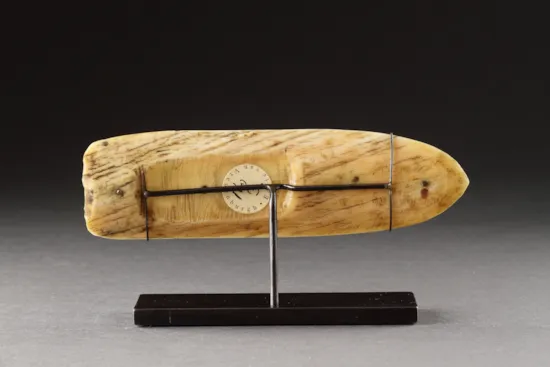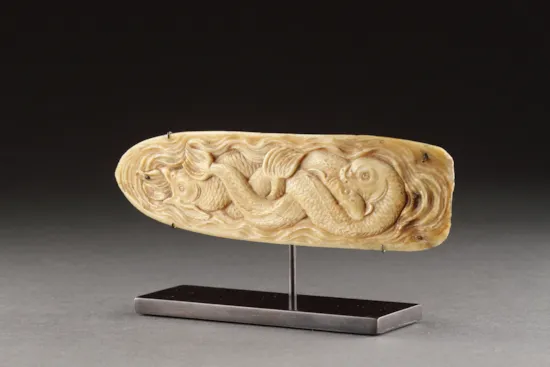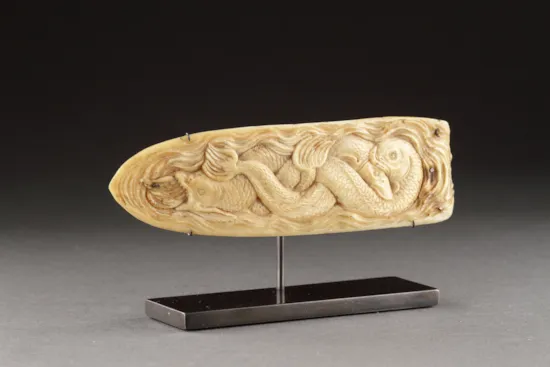Carved Narwhal Relief from a ‘Nef’
A Finely Carved Relief from a ‘Nef’
Depicting ‘sea-monsters’ entwined and writhing whilst devouring each other with ‘choppy’ waves to the border
Attributed to the workshop of Georg Pfründt (1603 - 1663)
Narwhal
Germany
17th Century
SIZE: 14cm wide, 4cm deep - 5½ ins wide, 1⁵⁄₈ ins deep
Depicting ‘sea-monsters’ entwined and writhing whilst devouring each other with ‘choppy’ waves to the border
Attributed to the workshop of Georg Pfründt (1603 - 1663)
Narwhal
Germany
17th Century
SIZE: 14cm wide, 4cm deep - 5½ ins wide, 1⁵⁄₈ ins deep
A Finely Carved Relief from a ‘Nef’
Depicting ‘sea-monsters’ entwined and writhing whilst devouring each other with ‘choppy’ waves to the border
Attributed to the workshop of Georg Pfründt (1603 - 1663)
Narwhal
Germany
17th Century
SIZE: 14cm wide, 4cm deep - 5½ ins wide, 1⁵⁄₈ ins deep
Depicting ‘sea-monsters’ entwined and writhing whilst devouring each other with ‘choppy’ waves to the border
Attributed to the workshop of Georg Pfründt (1603 - 1663)
Narwhal
Germany
17th Century
SIZE: 14cm wide, 4cm deep - 5½ ins wide, 1⁵⁄₈ ins deep
Georg Pfründt was born in Flachslanden, Germany in 1603. A pupil of Leonard Kern (1588 - 1662) there are numerous similarities between Kern, Johann Georg Kern (1622 - 1698) and Pfründt. The composition of exotic carved cups, goblets and elaborate mounted vessels were very popular in European Renaissance ‘Princely Kunstkammer’s’ with depictions of dolphins and sea-monsters carved in ivory and narwhal tusk, exotic materials in themselves, they were highly sought after and valued.
The 17th century ‘Kunstkammer’, or ‘art chamber’ developed out of the medieval treasury and, in turn, the Renaissance ‘studiolo’. The term was first recorded in 1550 in relation to the Holy Roman Emperor Ferdinand I (1503 - 1564) and his collection of precious objects and curiosities. In 1565, the Flemish writer Samuel von Quiccheberg differentiated between the ‘kunstkammer’, an ‘art chamber’, and the ‘wunderkammer’, a place of natural wonders ‘mirabilia’. Over the course of the ensuing decades the two were conflated and the ‘kunstkammer’ became a cabinet of natural and artificial wonders, from fine bronzes and paintings to un-carved gems and animal specimens. ‘Kunstkammern’ were a source of social and intellectual prestige, with two of the finest belonging to the Emperor Ferdinand II (1578 - 1637) at Schloss Ambras and the Emperor Rudolf II (1552 - 1612) at Prague Castle. Georg Pfründt died in 1663 in Durlach.
The 17th century ‘Kunstkammer’, or ‘art chamber’ developed out of the medieval treasury and, in turn, the Renaissance ‘studiolo’. The term was first recorded in 1550 in relation to the Holy Roman Emperor Ferdinand I (1503 - 1564) and his collection of precious objects and curiosities. In 1565, the Flemish writer Samuel von Quiccheberg differentiated between the ‘kunstkammer’, an ‘art chamber’, and the ‘wunderkammer’, a place of natural wonders ‘mirabilia’. Over the course of the ensuing decades the two were conflated and the ‘kunstkammer’ became a cabinet of natural and artificial wonders, from fine bronzes and paintings to un-carved gems and animal specimens. ‘Kunstkammern’ were a source of social and intellectual prestige, with two of the finest belonging to the Emperor Ferdinand II (1578 - 1637) at Schloss Ambras and the Emperor Rudolf II (1552 - 1612) at Prague Castle. Georg Pfründt died in 1663 in Durlach.
Ex Private collection Edric Van Vredenburgh, published no. 3, vol 1, EVV collection catalogue 2014
Ex Phillips Auction House, Bond Street, London (The Pink Room) early 1970’s
Ex Phillips Auction House, Bond Street, London (The Pink Room) early 1970’s
Carved Narwhal Relief from a ‘Nef’

SOLD




















YOU MAY ALSO LIKE

